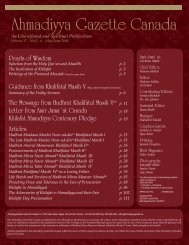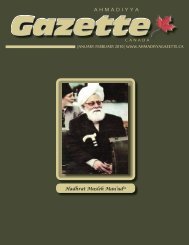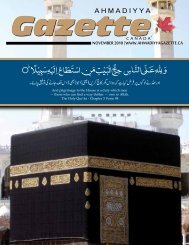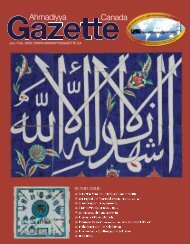English PDF - Ahmadiyya Gazette Canada
English PDF - Ahmadiyya Gazette Canada
English PDF - Ahmadiyya Gazette Canada
- No tags were found...
You also want an ePaper? Increase the reach of your titles
YUMPU automatically turns print PDFs into web optimized ePapers that Google loves.
purposely intended his creed tobe a compromise between thosetwo great religions.A careful investigation of earlySikh traditions points stronglyto the conclusion that thereligion of Nānak was reallyintended as a compromisebetween Hindūism andMuhammadanism, if it maynot even be spoken of as thereligion of a Muhammadansect. The very little that seemsto be known as to the views ofthe early Sikh teachers, coupledwith the decided opinion putforth by Dr. Trumpp, hasmade it necessary to give herea longer article on Sikhismthan its importance withrespect to lslām would haveotherwise warranted; becauseit was necessary to establishthe relationship which actuallyexisted between the twofaiths. It will be seen that theinformation given in this articleis chiefly taken from originalPanjabī books, and frommanuscripts in (the India OfficeLibrary; and it is supported bythe authority of the Ādi Granth,which is the sacred canon of theSikhs.Regarding the origin of Sikhism,Reverend Hughes is confident thatit emerged out of Sufīsm and thatBābā Nānak was himself a Sufī. Hewrites:The Janam-Sākhīs, orbiographical sketches of Nānakand his associates, contain aprofusion of curious traditionswhich throw considerable lighton the origin and developmentof the Sikh religion. From theseold books we learn that, in earlyBābā Gūrū Nānak—A Muslim Saintlife, Nānak, although a Hindu bybirth, came under Sufī influence,and was strangely attractedby the saintly demeanour ofthe faqīrs who were thicklyscattered over Northern Indiaand swarmed in the Punjab…It is, therefore, only reasonableto suppose that any Hindūaffected by Muhammadanismwould show some traces of Sufīinfluence. As a fact, we findthat the doctrines preached bythe Sikh Gūrūs were distinctlySufīistic and, indeed, the earlyGūrūs openly assumed themanners and dress of faqīrs,thus plainly announcing theirconnection with the Sufīisticside of Muhammadanism. Inpictures they are represented,with small rosaries in theirhands, quite in Muhammadanfashion, as though ready toperform zikr.Reverend Hughes further writesthat though Gūrū Arjun, the fifthGūrū was the first to lay aside thedress of a faqir in the doctrines butthe Sufī terminologies were stillused by all the Gūrūs. Like Sufīs,Gūrū Granth mentions God asthe Only Deity; the True One; theLight; the Beloved One; and manyother similar expressions foundboth in the Sufī literature and GūrūGranth Sahib. Even the mannerof compilation, states ReverendHughes, is a remarkable proof ofSufī influence. He writes:Another remarkable proof ofPersian influence is found in theform of the Adi Granth itself. Itconsists of a collection of shortpoems, in many of which allthe verses composing the poemrhyme together, in singularconformity with the principleregulating the constructionof the Persian ghazal. Thisresemblance is rendered morestriking by the fact that thename of Nānak is workedinto the composition of thelast line of each of the poems.This last characteristic is toopersistent to be considered theresult of accident, and whileit is altogether foreign to thepractice of Hindu verse, it isin precise accord with the rulefor the correct composition ofthe ghazal. The foregoing factsseem conclusive as to timeinfluence of Persian Sikhism onthe origin of the Sikh religionReverend Hughes quotes Dr.Trumpp (the first translator ofGūrū Granth Sahib), who, whilediscussing the philosophy ofthe Adi Granth, admits the intimateconnection between Sikhism andSufīism in the following words:“We can distinguish in theGranth a grosser and a finerkind of Pantheism…. In thisfiner shade of Pantheism,creation assumes the form ofemanation from the Supreme(as in the system of the Sufīs);the atomic matter is eitherlikewise considered coeternalwith the Absolute andimmanent in it, becomingmoulded into various, distinctforms by the energizing vigourof the absolute joti (light) or, thereality of matter is more or lessdenied (as by the Sufīs, whocall it theso thatthe Divine joti is the only realessence in all.”(Introductionto Translation of the AdiGranth, pp c. ci)19
















